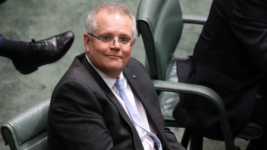Outrage as Morrison Continues Inaction on Violence Towards Women

The horrific quadruple murder of Hannah Clarke and her three young children by ex-partner Rowan Baxter on 19 February, drew national attention to the ongoing crisis of violence against women and their children, which annually takes the lives of many more than any local terror actions do.
Following the recent killings, PM Scott Morrison said all levels of government and the judiciary should reflect on them. And last Friday, women’s minister Marise Payne convened a special pre-COAG meeting of state and territory women’s safety ministers, where no ideas were “off the table”.
But, nothing happened. No new plans were forthcoming. Instead, social services minister Anne Ruston announced on International Women’s Day that the government is investing in a much criticised microloan scheme that was already launched back in late 2018.
The loan scheme, and a counselling program announced last year, have been criticised for placing the onus on the victims of domestic violence. However, they’re probably in line with the views of a PM who sees women’s empowerment as tantamount to men losing their place at the table.
And on Wednesday afternoon, a video started doing the social media rounds, which saw Women’s Safety NSW chief executive Hayley Foster condemning the government for having ignored the advice of the experts and failing to commit to any “serious action in addressing domestic violence”.
Serving up seconds
“Governments already have expert recommendations before them, which have not been acted upon to address our country’s domestic violence crisis,” Foster made clear, “but have chosen not to proceed with these recommendations due to ‘competing priorities’.”
“Women and children’s safety advocates across the country were hopeful that there would be meaningful commitments made at” the pre-COAG meeting,” she told Sydney Criminal Lawyers.
However, what the government served up was an old response. This involves $20 million in funding a interest free loan scheme that would provide women fleeing domestic violence situations with a one-off $2,000.
Women’s Safety NSW is part of the Australian Women Against Violence Alliance (AWAVA), which is a collaboration of specialist women’s organisations funded by the government, which provided the women’s safety ministers’ pre-COAG meeting with five key recommendations to consider.
“Not only were the recommendations of AWAVA ignored. Not only did the government commit to no new measures to tackle this urgent problem,” Ms Foster continued. “But, the key measure re-announced actually sent a very disturbing message about whose responsibility it is to address this.”
Victim blaming
The issue with the loan scheme, as Foster puts it, is it says to DV survivor-victims that “you got yourself into this mess, you can get yourself out of it.” It places extra financial hardship on the woman involved, and the advocate notes that the amount is hardly going to solve the problem.
This follows on the Morrison government’s last big announcement regarding the prevention of violence against women, when it committed $10 million in funding last April to a counselling and dispute resolution program for couples dealing with domestic violence.
Again, this sort of program places some of the responsibility as to why violence is occurring upon the victim on the receiving end, as it sees a couple discuss the reasons behind the male partner’s violence, in a manner that implies the female partner may have done something to lead to it.
Foster explained last year that when it comes to domestic and family violence, society has long moved past the idea that the victims have done something to cause it, and therefore have to take “mutual responsibility for resolving it”.
“Funding these programs is therefore extremely irresponsible,” Ms Foster went on. “It is also inconsistent with the government’s rhetoric around tackling gender inequality and disrespect towards women.”
The ignored recommendations
Following the recent murder of an entire Brisbane family, AWAVA consulted with its advisory body and came up with an approach to tackle gendered violence. It “went to the heart of what were apparent as failings in the system” in relation to the recent tragedy, Ms Foster explained.
The five key recommendations made include fully funding specialist women’s safety services and holding violent men to account. Removing the “presumption of equal shared parental responsibility” from family law. And initiating a national screening, risk assessment and referral process.
The alliance also recommends improving apprehended violence order (AVO) standards so as to ensure that women and children can rely on them, as well as making sure that all women reaching out for help can access assistance that’s suitable to her situation.
On improving AVOs, Ms Foster emphasises that there needs to be a move away from the practice of relying on non-custodial penalties for men who breach them. The AWAVA is not calling for mandatory sentencing, but rather specialist DV magistrates and police prosecutors.
And the other recommendation that Foster drew attention to was removing the presumption of equal shared parental responsibility in law, as she explains that at present regardless of how violent a partner is, a woman entering the system is warned that he will get some form of access.
The real domestic threat
According to Ms Foster, those working on the frontline in NSW are currently supporting over 50,000 women a year, who are accompanied by around 45,000 children. And as their services are stretched as it is, they can’t do anymore.
Meanwhile, as the government constantly rolls out further legislation to curb the threat of terrorism, it consistently makes token attempts at dealing with the much greater threat to the community, which arises within many households, and is often dealt with by a glance in the other direction.
“Why is the government preaching about gender equality and respecting women and yet completely dismissing women experts on women and children’s safety?” Ms Foster asked.
“You’d really have to ask them that question,” she then remarked in conclusion. “We’d be interested in the answer.”







